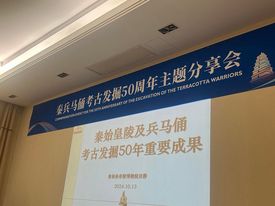This year celebrates 50 years since the discovery of the Terracotta Warriors, a major archaeological achievement of the 20th century. Recently, an international conference was held focusing on the preservation of the Qinshihuang Mausoleum and its surrounding heritage.
Furthermore, an exhibition was launched at the Qinshihuang Mausoleum Site Museum in Xi’an, Shaanxi Province, commemorating the 50th anniversary of the Terracotta Warriors’ discovery. This is the first exhibition of its kind, displaying 230 artifacts from significant finds over the past five decades.
History of Terracotta Warriors
In 1974, local farmers accidentally discovered fragments of clay while digging a well, leading to the unearthing of the Terracotta Warriors.
Around 2,000 life-sized clay soldiers and numerous weapons have been unearthed from three pits near Emperor Qinshihuang’s tomb. The Terracotta Army was listed as a UNESCO World Heritage site in 1987.
After five decades of excavation and study, archaeologists have discovered more than 10 above-ground structures and 500 underground burial pits and tombs at the mausoleum, unearthing over 50,000 relics.
Reflecting on 50 years of excavation, it’s evident that the Terracotta Warriors have transcended their archaeological significance to become a cultural symbol for China and the world, with an influence that extends beyond their historical value.
Li Gang, director of the Qinshihuang Mausoleum Site Museum, referred to the Terracotta Warriors as a “wonder” in world heritage exhibitions and a “gold business card” for promoting China’s cultural heritage globally.
Li emphasized the unique role of the Terracotta Warriors in strengthening Chinese identity, promoting cross-cultural exchanges, and contributing to global cultural governance by authentically showcasing China’s history.

Over the past five decades, archaeologists have uncovered the intricate layout of the mausoleum, centered on the emperor’s burial mound and surrounded by walls, pits, and tombs.
Artifacts from the site reveal the technological, material, and institutional developments that emerged with China’s unification under Emperor Qinshihuang.
Exhibition in Xi’an, Shaanxi Province
Some of the displayed artifacts during the exhibition in Xi’an, Shaanxi Province, including those from the eastern gate, architectural remains, and accompanying tombs, are being shown to the public for the first time.
According to Ye Ye, the exhibit’s design follows the mausoleum’s layout, highlighting its grand structures, burial pits, and artifacts, offering a vivid portrayal of life during the Qin Dynasty.
Since the first international exhibition of the Terracotta Warriors in Japan in 1976, these artifacts have toured 49 countries and nearly 200 cities, attracting over 20 million visitors, playing a significant role in sharing Chinese culture globally.
The Terracotta Warriors have also fostered international cooperation. In 2024, the Qinshihuang Mausoleum Site Museum marks its 45th anniversary, having partnered with institutions in countries like Germany, Belgium, and the UK, advancing heritage protection.
The site not only offers visitors a chance to see the “Eighth Wonder of the World” but also sets an example for the preservation and exhibition of large-scale archaeological heritage in China.

Moreover, the preservation efforts of the Terracotta Warriors reflect broader progress in China’s cultural heritage field, from restoring bronze chariots to using advanced technology to stabilize artifacts, showcasing China’s commitment to excellence in heritage conservation.
Related Posts
The Exhibition at the Zhangjiagang City Art Museum

















